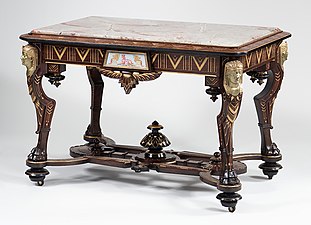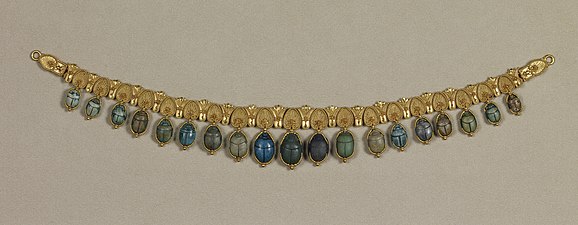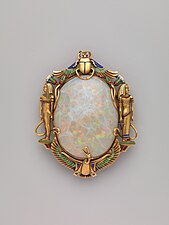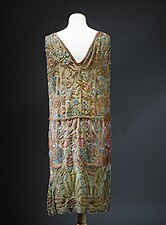
Egyptian revival decorative arts is a style in Western art, mainly of the early nineteenth century, in which Egyptian motifs were applied to a wide variety of decorative arts objects.
Enthusiasm for the artistic style of Ancient Egypt is generally attributed to the excitement over Napoleon's conquest of Egypt and, in Britain, to Admiral Nelson's defeat of Napoleon at the Battle of the Nile in 1798. Napoleon took a scientific expedition with him to Egypt. Publication of the expedition's work, the Description de l'Égypte, began in 1809 and came out in a series though 1826, inspiring everything from sofas with Sphinxes for legs, to tea sets painted with the pyramids. It was the popularity of the style that was new, Egyptianizing works of art had appeared in scattered European settings from the time of the Renaissance.
The Egyptian Gallery, a private room in the Duchess Street home of connoisseur Thomas Hope to display his Egyptian antiquities, and illustrated in engravings from his meticulous line drawings in his book, Household Furniture and Interior Decoration (1807), were a prime source for the Regency style in British furnishings. The book inspired a generation of fashionable English homeowners to install parlor suites featuring chairs, tables and sofas in shapes that evoked the objects depicted on Egyptian tomb paintings.
Later discoveries prompted further revivals, with the discovery of Tutankhamun's tomb creating an especially large revival in the 1920s. This revival in particular had a sizable influence on the Art Deco movement.
Gallery
-
Canopic jar, by Wedgwood, c.1773, earthenware and encaustic, Brooklyn Museum, New York City
-
 Table, 1775–1780, wood, carved, painted, and partly gilded, and black granite top not original to table, Metropolitan Museum of Art, New York City
Table, 1775–1780, wood, carved, painted, and partly gilded, and black granite top not original to table, Metropolitan Museum of Art, New York City
-
 Six-light candelabrums with stands, by Alexis Decaix, 1802–1806, gilt bronze, Metropolitan Museum of Art
Six-light candelabrums with stands, by Alexis Decaix, 1802–1806, gilt bronze, Metropolitan Museum of Art
-
 Empire style vase with pedestal, 1804–1806, varnished sheet and gilded bronze, Louvre
Empire style vase with pedestal, 1804–1806, varnished sheet and gilded bronze, Louvre
-
 Potpourri vase with pseudo-hieroglyphs, by the Königliche Porzellan-Manufaktur Berlin, c.1810, porcelain (painted & partially gilded), Neues Museum, Berlin
Potpourri vase with pseudo-hieroglyphs, by the Königliche Porzellan-Manufaktur Berlin, c.1810, porcelain (painted & partially gilded), Neues Museum, Berlin
-
 Signet with pharaoh head and Egyptian Revival motifs, c.1810, bronze, Neues Museum
Signet with pharaoh head and Egyptian Revival motifs, c.1810, bronze, Neues Museum
-
 Armchair, 1870–1875, rosewood and prickly juniper veneer, Metropolitan Museum of Art
Armchair, 1870–1875, rosewood and prickly juniper veneer, Metropolitan Museum of Art
-
 Center table, 1870–1875, rosewood, walnut and marble, Metropolitan Museum of Art
Center table, 1870–1875, rosewood, walnut and marble, Metropolitan Museum of Art
-
 Frame detail of The Death of the Pharaoh's Firstborn Son by Lawrence Alma-Tadema, unknown maker, 1872, painted and gilded wood
Frame detail of The Death of the Pharaoh's Firstborn Son by Lawrence Alma-Tadema, unknown maker, 1872, painted and gilded wood
-
 Pitcher, c.1872, silver, Metropolitan Museum of Art
Pitcher, c.1872, silver, Metropolitan Museum of Art
-
 Bed from 'Nouveaux modèles de Tentures (Bibliothèque de l'Ameublement)', 1875–1885, color lithography, Metropolitan Museum of Art
Bed from 'Nouveaux modèles de Tentures (Bibliothèque de l'Ameublement)', 1875–1885, color lithography, Metropolitan Museum of Art
-
 Polychrome majolica design, by Gaetano Lodi, 1885, drawing or painting on paper, unknown location
Polychrome majolica design, by Gaetano Lodi, 1885, drawing or painting on paper, unknown location
-
 Clock, by Tiffany & Co., c.1885, marble and bronze, Metropolitan Museum of Art
Clock, by Tiffany & Co., c.1885, marble and bronze, Metropolitan Museum of Art
-
 Ceremonial gift for Lord Kitchener, 1898, gilt silver, enamel and gems, Hessisches Landesmuseum Darmstadt, Darmstadt, Germany
Ceremonial gift for Lord Kitchener, 1898, gilt silver, enamel and gems, Hessisches Landesmuseum Darmstadt, Darmstadt, Germany
-
 Necklace with scarabs, by Giacinto Melillo, late 19th–early 20th century, gold, steatite and lapis lazuli, Walters Art Museum, Baltimore, USA
Necklace with scarabs, by Giacinto Melillo, late 19th–early 20th century, gold, steatite and lapis lazuli, Walters Art Museum, Baltimore, USA
-
 Brooch, c.1900, gold, amethyst, demantoid garnet, and enamel, Metropolitan Museum of Art
Brooch, c.1900, gold, amethyst, demantoid garnet, and enamel, Metropolitan Museum of Art
-
 Brooch, by Marcus & Co, c.1900, gold, opal, and enamel, Metropolitan Museum of Art
Brooch, by Marcus & Co, c.1900, gold, opal, and enamel, Metropolitan Museum of Art
-
Glass case with lotus columns at each corner, unknown maker, late 19th century, wood and glass, Macca House, Bucharest, Romania
-
 Art Deco dress decorated with lotus flower that are inspired by those found in Ancient Egyptian decoration, by Jenny (couturier) and Lesage (embroiderer), 1926, silk, metallic thread, and crocheted embroidery, Musée Galliera, Paris
Art Deco dress decorated with lotus flower that are inspired by those found in Ancient Egyptian decoration, by Jenny (couturier) and Lesage (embroiderer), 1926, silk, metallic thread, and crocheted embroidery, Musée Galliera, Paris
See also
Sources
- Egyptomania; Egypt in Western Art; 1730–1930, Jean-marcel Humbert, Michael Pantazzi and Christiane Ziegler, 1994
- The Egyptian revival : its sources, monuments, and meaning, 1808–1858, Richard G. Carrott, 1978
- The Egyptian Revival: Ancient Egypt as the Inspiration for Design Motifs in the West, James Stevens Curl, 2005
- Household Furniture and Interior Decoration, Thomas Hope, 1807
References
- Thomas Hope: Regency Designer, A Curatorial Interpretation of the Egyptian Room at Duchess Street
- When London and Paris Looked to the Nile for Inspiration, Wendy Moonan, July 11, 2008, New York Times
- Bixby, Allison (27 May 2020). "Eternally Chic: Erté and the Egyptian Revival of the 1920s". The Met Store. Metropolitan Museum of Art. Archived from the original on 22 July 2021. Retrieved 20 July 2021.
- Sund, July (2019). Exotic: A Fetish for the Foreign. Phaidon. p. 212. ISBN 978-0-7148-7637-5.
- Muriel Barbier. "Egyptian vase and pedestal". louvre.fr. Retrieved 12 March 2021.